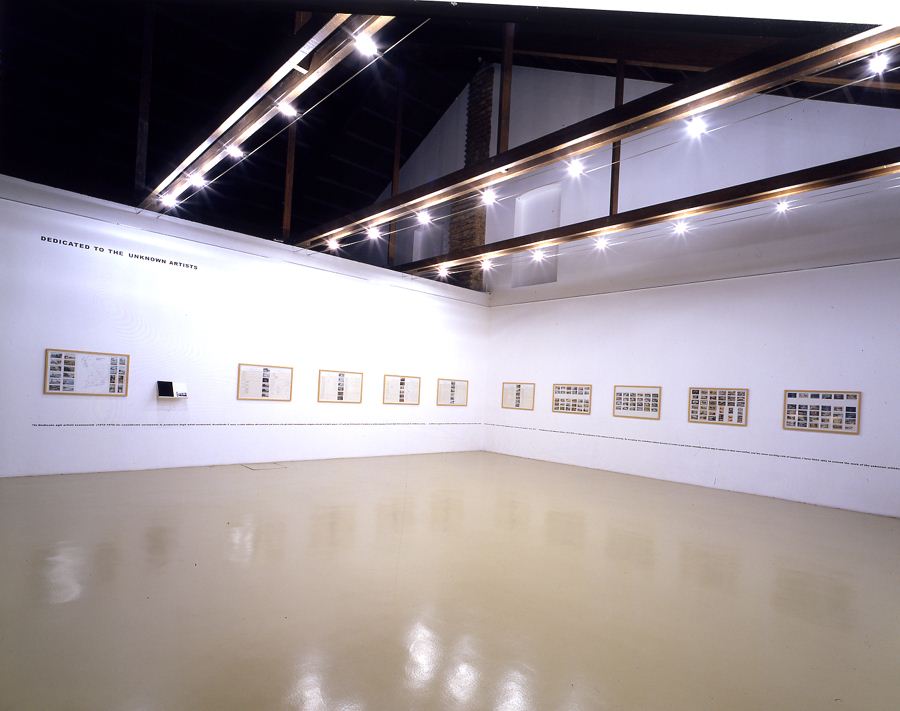Susan Hiller

10 march 2006 - 30 july 2006
Concetto, Corpo e Sogno (Concept, Body and Dream)
Curated by Carolyn Christov-Bakargiev
Concetto, Corpo e Sogno (Concept, Body and Dream) is a series of five exhibitions which will be held successively throughout the spring and summer of 2006. Solo shows will be dedicated to conceptual artists. Each exhibition gathers together works and more recent, or previously unseen projects, and is accompanied by an interview with each artist.
Thanks to the support of the Fondazione CRT Progetto Arte Moderna e Contemporanea, many of the works exhibited have become part of the museum’s permanent collection.
The artist Susan Hiller (Florida,1940) explores the mind’s more mysterious and irrational side through performances, artist’s books, installations of images and texts, collective events realized with the participation of groups of people, sculptural objects and audio and video installations. he is also the author of numerous books and theoretical writings on art and culture.
During the late 1960s and 1970s Conceptual Art developed through the works of a number of artists who radically changed our notions of what art can be. They believed that it was more important to ‘think’ art than to actually produce individual artworks, and they moved away from traditional painting and sculpture. Their works were often de-materialized and verbal language in the artworks themselves came to the forefront. It is during this period that Hiller’s art matured.
In 1969, after having studied art and anthropology in the United States, the artist moved to London. In contrast to the more rationalist schools of Conceptual Art and Minimalism, Hiller became known for her works based on methods hitherto associated with anthropology rather than with art. If classical Conceptual art of the 1960’s and 1970’s explored art and experience through a ‘diurnal’ gaze, Hiller’s attention focused instead on the nocturnal and bizarre aspects of life. In highlighting obscure areas and places of everyday life which apparently tend to be overlooked because they appear to be less important, or aspects of our shared cultural production which have been forgotten, her various project are investigations of our culture’s subconscious.
The artist examines evil, dreams, and the eruption of the subconscious into daily life, casting both a conceptual and anthropological eye on the mysterious and hidden workings of the mind, on the relationship between the visible and invisible world, and on madness.
In this first solo Italian exhibition at the Castello di Rivoli, Hiller presents two of her most significant early works in gallery 34: Dedicated to the Unknown Artists (1972-76),which addresses the frequent desire to portray the tumultuous sea, and Dream Mapping (1974), which explores our impulse to dream. In Dream Mapping (1974) Hiller set up a dream study laboratory. In 1973 she organized a seminar to study dreams and oneiric productions. The final event was a three-day trip to the countryside in Hampshire where participants camped on a field and noted and mapped their dreams in notebooks every morning. Personal experience was shared, and this project reflects on the boundaries between private and public. This project is presented through the notebooks kept by the participants during the experimental journey. Dedicated to the Unknown Artists (1972-1976) is a work that explores our fascination for the sublime and for untamable nature. In 1972 Hiller began to collect postcards of the rough sea in various locations of Great Britain. The anonymous personal expressions contained in the over 300 postcards of photographs and paintings of stormy seas that she had collected are the expression of a multitude of anonymous people from the late 1900s to today. Based on museological models of presentation, Hiller’s project reflects on the impossibility of ever truly ‘ordering’ culture even while it recalls archival methods and the analysis of cultural artifacts according to type, location, or other characteristics. The artist thereby performs a poetic shift or transformation of analytical and functional thought typical of most Conceptual Art. Gallery 35 presents the recent audio installation Witness (2000) made for a church in London as an Artangel commission. In this recent audio installation, the artist creates an acoustic labyrinth in which recorded voices are played back from micro-speakers. These voices describe the experience of sighting unidentified flying objects in different language. A social study of this phenomenon, Hiller collected numerous tales from various sources all over the world, including the Internet. The installation suggests the theme spatially: the audience moves though a dark yet luminous cloud of unexplainable presences created by the tiny speakers that hang from the ceiling at different heights, thus becoming mysterious technological phenomena.
Carolyn Christov-Bakargiev